Aldi Executive Reveals How the Grocery Chain Keeps Prices So Low

Beyond its rapid growth and coin-operated shopping carts, Aldi is arguably best known for its low prices. So how does Aldi manage to keep its products so affordable? There are several factors, according to the chain’s CEO Jason Hart, who recently spoke to The Wall Street Journal.
One component of Aldi’s business model is carrying less inventory than major supermarket operators. The German grocery chain offers around 2,000 items versus the average of 31,000, according to the food industry trade group FMI. As reported by The Wall Street Journal, this allows Aldi to buy larger volumes of products from suppliers at a lower price.
Looking at Aldi’s inventory more closely, Hart told the news outlet that about 90% of the grocer’s products are private label. Removing some national brands allows Aldi to produce and sell its own items and offer them for less. Plus, the higher volumes enable Aldi to negotiate cheaper prices with suppliers. Some of Aldi’s private-label brands include Simply Nature, Specially Selected, and liveGFree.

The Wall Street Journal reported that a basket of 50 typical household items at Aldi was around 6% less expensive than Walmart during the first three months of 2024. Meanwhile, fresh and frozen items were almost 16% cheaper at Aldi.
Another way the German grocer cuts costs is by keeping products in their pallets, so employees don’t need to spend time unpacking and stocking. The stores are also smaller in size—usually about 20,000 square feet. This is less than half the size of an average grocery store. The smaller size keeps rent and energy costs down and requires fewer employees.
The money-saving efforts don’t stop there. Last year, Aldi spent around $20 million switching to digital price tags. This saved the company about 156 tons of paper in addition to the time it would take employees to swap out the paper price tags.
Additionally, Hart said the company saved about $60 million in transportation costs last summer by outsourcing its freight businesses to different carriers with competitive prices. Aldi passed these savings on to customers by lowering the prices of fresh meat in return.
The grocer’s foot traffic increased by about 26% in March compared to last year. This beat out the 6% increase at Kroger and the 15% climb at Trader Joe’s, according to Placer.ai, a foot traffic analytics company.
Going forward, Aldi intends to keep growing. In March, the discount grocery chain announced plans to open 800 stores across the United States by the end of 2028. There are currently 2,372 Aldi stores in the U.S., according the the company’s website.









